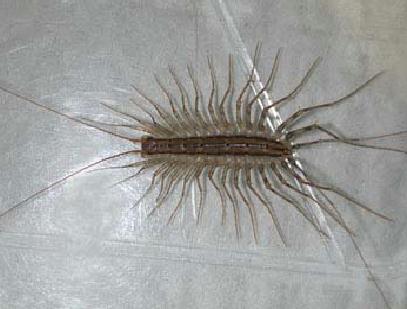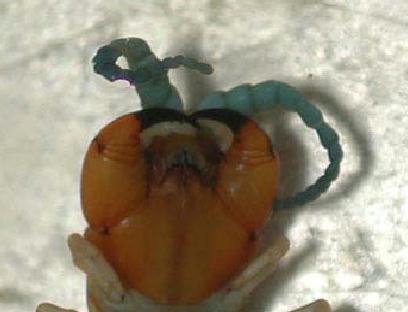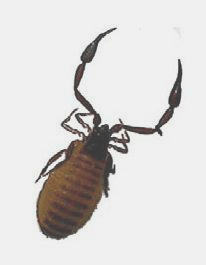Centipedes and Pseudoscorpions
ENTFACT-647: Centipedes and Pseudoscorpions | Download PDF
by Lee Townsend and Mike Potter, Extension Entomologist
University of Kentucky College of Agriculture
CENTIPEDES
Centipedes or "hundred-leggers" are predators that use sharp fangs to inject venom into the insects and other small creatures on which they feed. Centipedes are usually active at night and hide in cracks or under objects. They prefer dark, humid areas under rocks, mulch, leaf litter, or beneath loose bark in rotting logs. Individual centipedes may live for a year or more.
Centipedes can enter homes by crawling under doors or through most any small opening, such as where pipes or wires enter a structure. Once inside, they may be anywhere in the house but tend to favor undisturbed areas in garages, bathrooms, basements, and crawl spaces which provide hiding spaces and food.
Long-legged house centipedes are relatively common in houses. They run across the floor very quickly, stop suddenly for a moment, then run off again, trying to crawl under something if they can.

House Centipede
While most people view them as repulsive, they are not dangerous because their small mouthparts cannot penetrate the skin very well.
Large centipedes, like Scolopendra with their blue body and shorter legs, are much more impressive. Their fangs are very stout and sharp so they can give a painful bite if handled or accidentally mashed by bare skin. The bite can be painful, cause some localized inflammation. Usually, the pain fades away in 4 to 5 hours but in some cases, the site may be irritated for several days, especially if it were to become infected.
The head of the Scolopendra centipede is to the right in the picture below. Notice that the tail end looks very similar to the head. The relatively bright blue and orange colors may serve as a warning to birds or mammals that this creature can give a painful bite if disturbed.

Scolopendra centipede

View of the head from below showing the sharp, black-tipped fangs
Management
Minimize Moisture, Remove Debris - Problems with these pests often coincides with excessively wet weather; patience and drier conditions often will correct the problem. The most effective, long-term measure for reducing entry of centipedes and their prey is to minimize moisture and hiding places, especially near the foundation. Leaves, grass clippings, heavy accumulations of mulch, boards, stones, boxes, and similar items laying on the ground beside the foundation should be removed, since these often attract and harbor pests. Items that cannot be removed should be elevated off the ground.
Don't allow water to accumulate near the foundation or in the crawl space. Water should be diverted away from the foundation wall with properly functioning gutters, down spouts and splash blocks. Leaking faucets, water pipes and air conditioning units should be repaired, and lawn sprinklers should be adjusted to minimize puddling. Homes with poor drainage may need to have tiles or drains installed, or the ground sloped to so that surface water drains away from the building. Humidity in crawl spaces and basements should be reduced by providing adequate ventilation, sump pumps, polyethylene soil covers, etc.
Seal Pest Entry Points - Seal cracks and openings in the outside foundation wall, and around the bottoms of doors and basement windows. Install tight-fitting door sweeps or thresholds at the base of all exterior entry doors, and apply caulk along the bottom outside edge and sides of door thresholds. Seal expansion joints where outdoor patios, sunrooms and sidewalks abut the foundation. Expansion joints and gaps should also be scaled along the bottom of basement walls on the interior to reduce entry of pests and moisture from outdoors.
Insecticides - Application of insecticides along baseboards and other interior living areas of the home are of little use in controlling centipedes. Most wandering centipedes which end up indoors soon die from a lack of moisture. Removal with a vacuum or broom is all that is needed.
Insecticides may help to reduce inward invasion of these and other pests when applied outdoors, along the bottom of exterior doors, around crawl space entrances, foundation vents and utility openings, and up underneath siding. It also may be useful to treat along the ground beside the foundation in mulch and ornamental plant beds, and a few feet up the base of the foundation wall. Heavy accumulations of mulch and leaf litter should first be raked back to expose pest hiding areas. Insecticide treatment may also be warranted along the interior foundation walls of damp crawl spaces and unfinished basements.
Various insecticides sold in hardware/lawn and garden shops are effective, including Sevin and synthetic pyrethroids (e.g., Spectracide Bug Stop, Ortho Home Defense System). Treatment can be accomplished with a compressed air "pump up" or hose end sprayer. Dust formulations (e.g., silica get, diatomaceous earth) also work well for treating cracks, weep holes, and similar openings in the foundation.

Pseudoscorpion
PSEUDOSCORPIONS
Pseudoscorpions are small (usually less than 3/16 inch long) flattened, oval-bodied creatures with a large claw on each front leg. Pseudoscorpions look like tailless scorpions without stingers. Pseudoscorpions usually live under bark, stones, or leaf litter. They can run sideways or backwards very quickly.
These small predators feed on small insects and mites, which they catch with their claws.
Pseudoscorpions can be found throughout North America and are harmless. Usually, only a single one is found. There is no need for any control measure other than to sweep up and discard it.
Issued: 05/03
Revised: 05/03
CAUTION! Pesticide recommendations in this publication are registered for use in Kentucky, USA ONLY! The use of some products may not be legal in your state or country. Please check with your local county agent or regulatory official before using any pesticide mentioned in this publication.
Of course, ALWAYS READ AND FOLLOW LABEL DIRECTIONS FOR SAFE USE OF ANY PESTICIDE!
Images: Lee Townsend, University of Kentucky Entomology.
